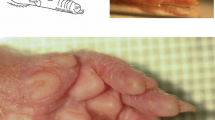Summary
-
1.
Mechanoreceptors in the trigeminal area of ducks and pigeons have been studied with regard to the dependence of the response to rectangular mechanical stimuli on skin temperature. Single unit activity was recorded from peripheral branches of the mandibular nerve.
-
2.
The response to a standard mechanical stimulus has been studied in the temperature range 10 ° to 50 °C. In pigeons the response/stimulus increased with increasing temperature up to 40 °C; above 40 °C there was either a further slight increase or a decrease in response. In ducks the response/stimulus reached maximal values between 20 ° and 30 °C; at 40 °C the response was greatly reduced in each case.
-
3.
Adaptation to the mechanical stimulus was nearly independent of temperature in both slowly and relative rapidly adapting mechanoreceptors in pigeons. The relative rapidly adapting mechanoreceptors in ducks showed a slight increase of adaptation with increasing temperature, i.e., the impulse frequency declined more rapidly at higher temperatures.
Similar content being viewed by others
References
Boldt, W., Biewald, G. A.: Impulsmuster cutaner Mechanorezeptoren des Feldhamsters (Cricetus cricetus L.) bei verschiedenen Hauttemperaturen. Zool. Jb. Abt. allg. Zool. u. Physiol.75, 479–492 (1971)
Burgess, P. R., Perl, E. R.: Cutaneous mechanoreceptors. In: Handbook of sensory physiology, vol. II. Somatosensory system (ed. A. Iggo). Berlin-Heidelberg-New York: Springer 1973
Burkhardt, D.: Die Erregungsvorgänge sensibler Ganglienzellen in Abhängigkeit von der Temperatur. Biol. Zbl.78, 22–62 (1959)
Dorward, P. K.: Response patterns of cutaneous mechanoreceptors in the domestic duck. Comp. Biochem. Physiol.35, 729–735 (1970)
Dorward, P. K., McIntyre, A. K.: Response of vibration-sensitive receptors in the interosseous region of the duck's hind limb. J. Physiol. (Lond.)219, 77–87 (1971)
Gregory, J. E.: An electrophysiological investigation of the receptor apparatus of the duck's bill. J. Physiol. (Lond.)229, 151–164 (1973)
Iggo, A., Muir, A. R.: The structure and function of a slowly adapting touch corpuscle in hairy skin. J. Physiol. (Lond.)200, 763–796 (1969)
Kitchell, R. L., Ström, L., Zotterman, Y.: Electrophysiological studies of the thermal and taste reception in chickens and pigeons. Acta physiol. scand.46, 133–151 (1959)
Necker, R.: Response of trigeminal ganglion neurons to thermal stimulation of the beak in pigeons. J. comp. Physiol.78, 307–314 (1972)
Necker, R.: Temperature sensitivity of thermoreceptors and mechanoreceptors on the beak of pigeons. J. comp. Physiol.87, 379–391 (1973)
Necker, R.: Temperature sensitivity of slowly-adapting mechanoreceptors on the beak of pigeons. Symposium Mechanoreception, Bochum, 1973 (in press, 1974a)
Necker, R.: Dependence of mechanoreceptor activity on skin temperature in sauropsids. I. Caiman. J. comp. Physiol.92, 65–73 (1974b)
Oyama, O.: The effects of temperature on the dynamic and static sensitivities of the frog muscle spindle. Nagoya J. med. Sci.33, 13–25 (1970)
Quilliam, T. A.: Unit design and array patterns in receptor organs. In: Ciba Foundation Symp. Touch, Heat and Pain (ed. De Reuck, A. V. S. and J. Knight). London: J. & A. Churchill Ltd. 1966
Späth, M.: Die Wirkung der Temperatur auf die Mechanorezeptoren des KnochenfischesLeuciscus rutilus L. Z. vergl. Physiol.56, 431–462 (1967)
Witt, I., Hensel, H.: Afferente Impulse aus der Extremitätenhaut der Katze bei thermischer und mechanischer Reizung. Pflügers Arch. ges. Physiol.268, 582–596 (1959)
Author information
Authors and Affiliations
Additional information
Supported by the Deutsche Forschungsgemeinschaft (SFB 114).
Rights and permissions
About this article
Cite this article
Necker, R. Dependence of mechanoreceptor activity on skin temperature in sauropsids. J. Comp. Physiol. 92, 75–83 (1974). https://doi.org/10.1007/BF00696528
Received:
Issue Date:
DOI: https://doi.org/10.1007/BF00696528




